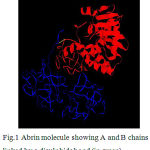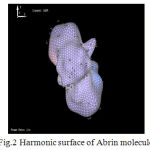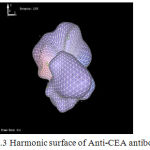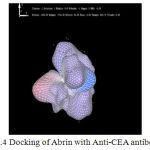Manuscript accepted on :May 20, 2009
Published online on: 13-11-2015
Plagiarism Check: Yes
SumaBhaskar1, 2 and T. R. S. Chouhan3
¹Dr. M. G. R. Educational and Research Institute (Deemed University), Chennai - 600 095 India.
²Department of Physiology, Adichunchanagiri Institute of Medical Sciences, B. G. Nagara-571448, Nagamangala Taluk, Mandya District, Karnataka India.
³Director, Ethicamatrix CRO Pvt. Ltd, Erragadda, Hyderabad - 500 038 India.
Corresponding Author E-mail:suma.bhaskar@gmail.com
Abstract
Molecular modeling has become an essential tool in the process of rational drug designing. The interaction between a ligand and its receptor plays a significant role in structure-based drug designing. There is a growing need of improved anticancer agents with more specificity as carcinomas are often unresponsive to or eventually acquire resistance to chemotherapy. In our present study, we have taken a powerful toxic protein molecule, Abrin, as the ligand molecule and docked it with a monoclonal antibody against Carcinoembryonic antigen (CEA) using a computational molecular docking program called Hex 5.1. The results are indicated in terms of energy values with the docked complex achieving an E-value of -658.50. The least energy levels indicate high binding efficiency and steric compatibility. This infers that Abrin can be used as a lead compound since it has a high negative E-value to design a potential anticancer drug which can specifically kill cells over expressing CEA antigens such as in colorectal cancer. These insilico results can thus serve as a template for further studies invitro and invivo.
Keywords
Abrin, R. I. P; Docking; Hex 5.1; Carcinoembryonic antigen; Anti-CEA
Download this article as:| Copy the following to cite this article: SumaBhaskar, Chouhan T. R. S. Docking Studies of Abrin with Anti-CEA Antibody-It’s Implications in Drug Design. Biomed. Pharmacol. J.2009;2(1) |
| Copy the following to cite this URL: SumaBhaskar, Chouhan T. R. S. Docking Studies of Abrin with Anti-CEA Antibody-It’s Implications in Drug Design. Biomed. Pharmacol. J.2009;2(1). Available from: http://biomedpharmajournal.org/?p=642 |
Introduction
Cancer is known to be the leading cause of death worldwide, of which lung, breast, colorectal, stomach and liver cancer cause the most cancer deaths each year. The disease accounted for 7.4 million deaths (or around 13% of all deaths worldwide) in 2004 alone and it has been projected to continue rising, with an estimated 12 million deaths in 2030 (1). Despite recent advances in cancer treatment, a large proportion of patients still remain uncured. This necessitates the need for developing effective therapeutic agents for treatment of cancer. Methods used to develop, facilitate and speedup the drug designing process are known as Rational Drug Design (RDD).These processes are used in biopharmaceutical industry to discover and develop new drugs. RDD uses a variety of computational methods to identify novel compounds (2). One of those methods is molecular docking of proteins/potential drug molecules with their ligands/receptors, which are the site of drug action. Docking simulations, as opposed to binding simulations, are not concerned with modeling of real binding pathways, but rather focus on the final configuration(s) of the complex. This makes docking computationally efficient and potentially suitable for high-throughput “first approximation” structural analysis on a genome scale. Because proteins are 3D objects, the importance of the direct 3D analysis of protein-protein interactions is obvious. Such analysis is necessary for the prediction of these interactions, their adequate study, and for further applications such as structure-based drug design (3).
Chemotherapuetic agents are most widely used in cancer treatment. None of the cytotoxic agents in current use act specifically and they also cause several side effects. Carcinomas are often unresponsive to or eventually acquire resistance to chemotherapy. Therefore, numerous studies for an alternative and effective cancer treatment have been performed (4). Several drug-monoclonal antibody conjugates have been extensively studied for their cytotoxicity (5, 6, 7). Since these act stoichiometrically, the number of drug molecules delivered to each cell is rather small and might not be sufficient to result in cytotoxicity. There are more potent substances such as toxins which act catalytically so that even one single toxin molecule delivered to the cytoplasm can kill a cell (8, 9, 10). With the development of monoclonal antibody technology, antibody mediated delivery of toxic reagents to cells has been suggested for experimental and therapeutic applications. Immunotoxins, which are conjugates of toxins with antibodies recognizing tumor associated antigens have been shown to exert specific toxic effects in cell culture, in animal models and recently, in clinical trials for cancer patients (11).
Carcinoembryonic antigen (CEA) has been shown to be a marker for several cancers originating from the endodermally derived epithelium of the digestive tract, including tissue from the embryonic gut, pancrease, and liver (12, 13). Because CEA is usually expressed at high levels in adenocarcinomas of the colon and pancreatic ducts, it is considered as one of the most clinically significant tumor markers for colorectal cancer, providing information on prognosis, tumor recurrence, and metastasis
In the present paper, we have made an effort to design an immunotoxin, which is a conjugate of a powerful toxin called abrin and a monoclonal antibody against CEA using a docking program called Hex 5.1 version. Abrin is a type-II ribosome inactivating protein [RIP] found in the seeds of Abrus precatorius. It is a heterodimer made up of two chains- A and B linked by means of a disulphide bond (Fig. 1). The B chain binds to the cell surface receptors made of glycoproteins and glycolipids containing terminal galactose on the eukaryotic cell surface and facilitates the entry of toxic A-chain into the cell by receptor-mediated endocytosis. The A-chain inhibits protein synthesis through its N-Glycosidase activity by depurinating a specific adenine residue from the GAGA/sarcin/ricin loop of 28S rRNA from 60S ribosome. This region is crucial for ribosomal function, as it is involved in elongation factor-1 (EF-1)-dependent binding of aminoacyl-tRNA and EF-2 catalyzed GTP hydrolysis and translocation. Action of abrin A-chain in the sarcin/ricin loop leads to loss of stability of the loop and thus impairs protein synthesis. Besides the inhibition of protein synthesis, abrin has been shown to induce Apoptosis or Programmed cell death (PCD). It brings about PCD by activating Caspase 3; a Caspase known to degrade many structural and regulating proteins as well as proteins involved in DNA repair and also triggers DNA fragmentation leading to cell death by 12 hours. Hence, molecules like abrin and other similar proteins may have tremendous potential as possible therapeutic agents (14).
 |
Figure 1: Abrin molecule showing A and B chains linked by a disulphide bond (in green).
|
Materials and Methods
The structures of abrin holotoxin and anti-CEA antibody were retrieved from the Research Collaboratory for Structural Bioinformatics (RCSB) Protein data bank (PDB) (15). For the docking analysis, we have used Hex 5.1, a molecular graphics program, which calculates and displays feasible docking pairs of molecules using spherical polar Fourier correlations with low energy docked conformations. Docking is the process by which two molecules fit together in 3-dimensional space. Docking allows one to virtually screen a database of compounds and predict the strongest binders based on various scoring functions. During the course of the process, the ligand and the protein adjust their conformation to achieve an overall “best-fit” like a 3-dimensional hand-in-glove analogy, and this kind of conformational adjustments resulting in the overall binding is referred to as “induced-fit”. Hence docking plays an important role in the “Rational Design of Drugs (RDD)” (14) . The docking analysis of Abrin holotoxin with anti-CEA antibody and their relative stabilities were evaluated using molecular dynamics and their binding affinities, using free energy simulations. All the experiments were done in triplicates to ensure reproducible results.
Results and Discussions
The docking results tabulated in the Table-1 show that the interactions of abrin holotoxin with the anti-CEA antibody have a high negative energy value. This infers that Abrin holotoxin can be used as the lead molecule since it has maximum interaction having high negative e-value. The table also shows that the bumps are -1, which indicates that the steric clashes are minimal, and therefore it is a favorable interaction.
Table 1: Docking results of Abrin holotoxin with anti-CEA antibody
| RIP | Receptor | Energy values | Bumps |
| Abrin | anti-CEA antibody | -658.50 | -1 |
 |
Figure 2: Harmonic surface of Abrin molecule.
|
 |
Figure 3: Harmonic surface of Anti-CEA antibody.
|
 |
Figure 4: Docking of Abrin with Anti-CEA antibody.
|
Conclusion
Computational docking simulation programs such as Hex provide a useful alternative method to study the protein-protein or ligand-receptor interactions insilico. Our data from the docking analysis reveals that Abrin-Anti-CEA antibody complex show maximum intermolecular interactions, minimum energy and steric hindrances. This clearly indicates Abrin can be used as the lead compound to design a potential drug which can selectively kill cells over expressing CEA antigens as is the case in colorectal cancer. The results from our insilico study thus provide a platform for further investigations to be carried out invitro and invivo which will greatly enhance the probability of success in the discovery of an anticancer agent with specificity.
References
- “Cancer” World Health Organization. (February 2009). http://www.who.int/mediacentre/factsheets/fs297/en/.
- Virupakshaiah, D. B. M., Kelmani, C., Patil, R., and Hegade, P. (October 2007). Computer Aided Docking Studies on Antiviral Drugs for SARS. World Acad. Sci., Eng. Tech., Vol. 24, 297-299.
- Tovchigrechko, A., Wells, C. A., and Vakser, I. A. (2002). Docking of protein models. Protein Sci. Vol. 11, 1888-1896.
- Manosroi, J., Kleist, S. V., Manosroi, A., and Grunert, F. (1992). Thermostability and Antitumor Activity on Colon Cancer Cell Lines of Monoclonal Anti-CEA Antibody-Saporin Immunotoxin. Korean Med. Sci. Vol. 7 (2), 128-135.
- Casson, A. G., Ford, C. H., Marsden, C. H., Gallant, M. E., and Bartlett, S. E. (1987). Efficacy and selectivity of vindesine monoclonal anti-carcinoembryonic antigen antibody conjugates on human tumor cell lines grown as xenografts in nude mice. NCI Monogr. 3, 117-124.
- Corvalan, J. R., and Smith, W. (1987). Construction and characterization of a hybrid monoclonal antibody recognizing both Carcinoembryonic antigen (CEA) and vinca alkaloids. Cancer Immunol. Immunother. Vol. 24 (2), 133-137.
- Corvalan, J. R., Smith, W., Gore, V. A., Brandon, D. R., and Rye, P. J. (1987b). Increased therapeutic effect of vinca alkaloids targeted to tumor by hybrid-hybrid monoclonal antibody. Cancer Immunol. Immunother. Vol. 24 (2), 138-143.
- Eiklid, K., and Olsnes, S. (1980). Interaction of Shigella shigae cytotoxin with receptor on sensitive and insensitive cells. J. Rec. Res. 1, 199-213.
- Eiklid, K., Olsnes, S. and Pihl, A. (1980). Entry of lethal doses of abrin, ricin and modeccin into cytosol of Hela cells. Cess. Res. Vol. 126, 321-326.
- Yama Izumi, M., Mekada, E., Uchida, T., and Okada, Y. (1987). One molecule of diphtheria toxin fragment A introduced into a cell can kill the cell. Cell, Vol. 15, 245-250.
- Tsai, L. C., Chen, Y. L., Lee, C., Chen, H. M., Chang, Z.N., Hung, M. W., Chao, P. L., and Lin, J. Y. (1995). Growth suppression of human colorectal carcinoma in nude mice by monoclonal antibody C27-abrin A chain conjugate. Dis. Colon Rectum. Vol. 38 (10), 1067-
- Gold, P. and Freedman, S.O. (1965). Specific carcinoembryonic antigens of the human digestive system. Exp. Med. Vol. 122 (3), 467–481.
- Gold, P., Shuster, J., and Freedman, S.O. (1978). Carcinoembryonic antigen (CEA) in clinical medicine: historical perspectives, pitfalls and projections. Cancer, 42 (3), 1399–1405.
- SumaBhaskar, and Chouhan T. R. S. (2009). Insilico and invitro studies of Abrin-a ribosome inactivating protein on Candida albicans. Accepted for publication in Biosciences, Biotechnology Research Asia, 6 (1), 2009.
- http://www.pdb.org/







